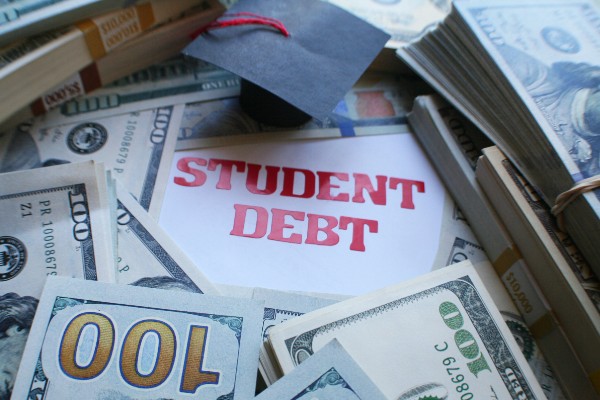
New Process Makes It Easier to Discharge Student Loan Debt in Bankruptcy
The numbers are staggering. Federal Reserve data shows that Americans are shouldering student loan debt totaling $1.74 trillion. That equates to $35,210 per borrower. Yet a college graduate holding a bachelor’s degree earns an average annual salary of just $74,500.
That makes paying off student loan debt difficult. Financial experts say borrowers should pay off their student loans within 10 years. According to the Education Data Initiative, however, it takes the average borrower 20 years to pay off student loan debt, with some professional graduates taking 45 years or more. Student borrowers who defer payments often see their debt balances increase as interest accrues. Some loans have interest rates as high as 8%.
Easing the burden of student loan debt has been a focus of the Biden administration. Biden’s original plan was to cancel up to $20,000 in federal student loan debt for up to 40 million people. When the Supreme Court struck down that plan, the president promised to find a different path. The details of the second plan have not been released, but the administration has meanwhile eased the way for borrowers to discharge student loan debt in bankruptcy.
The ‘Undue Hardship’ Test
Existing bankruptcy law makes that extremely difficult to do. Under Section 523(a)(8) of the Bankruptcy Code, student loans may not be discharged unless the debtor shows “undue hardship.” Although the Bankruptcy Code does not define “undue hardship,” a 1987 Second Circuit decision defined a three-part test that most courts follow.
In Brunner v. New York State Higher Education Services Corp., the Second Circuit held that a debtor must meet three requirements to establish undue hardship:
The debtor must be unable to maintain a “minimal” standard of living if required to repay the loans.
The debtor must show that, based on the entirety of the circumstances, the situation would persist for most of the repayment period.
The debtor must have made efforts in good faith to repay the loans.
The court found that Congress displayed a clear intent to make the discharge of student loan debt difficult. Furthermore, the court determined that the second element of the test was justified by the fact that predicting a debtor’s future income is difficult.
Why ‘Undue Hardship’ Is Unfair
The second prong of the test has received the most criticism. In 1985, when Brunner was first decided, borrowers could discharge student loan debts after five years. Therefore, the rule was designed to prevent borrowers from seeking to discharge student loan debt shortly after graduation, when their income would be low. That reasoning no longer applies today given that the waiting period has been eliminated and repayment often takes decades. In addition, many debtors cannot make consistent payments if their financial situation is dire and thus cannot meet the third prong of the test.
The First and Eighth Circuits use the “totality of the circumstances” test, which considers the debtor’s past, present, and future financial resources, reasonably necessary living expenses, and other relevant circumstances. This test is considered more flexible, offering a better chance of proving undue hardship. However, critics contend that a borrower’s past resources are irrelevant, and only the present and future ability to repay should be considered.
In practice, courts almost never find undue hardship. Borrowers must sue the lender, which may be the federal government, and try to prove that repayment is utterly hopeless. The odds of prevailing against the enormous powers of the government and private lenders are slim. In the few cases where undue hardship was found, the borrowers suffered severe physical or mental disabilities.
New Guidance Helps Relieve the Burden
Guidance released in November 2022 by the Departments of Education and Justice bypasses the adversarial process by allowing borrowers to self-attest to undue hardship. The self-attestation form eliminates the need for the Justice Department to conduct time-consuming investigations before recommending to a bankruptcy court judge that the borrower deserves relief. The guidance also establishes clearer guidelines for discharging student loan debt to enable more consistent treatment of borrowers.
On November 22, 2023, the Justice Department reported on the impact of the new process. In the first 10 months, 632 cases were filed and 99% of borrowers whose cases have been adjudicated were granted full or partial discharge. Still, those cases represent a tiny fraction of the almost 40 million federal student loan borrowers, and many adversarial cases remain pending.
In 2018, Federal Reserve Chairman Jerome Powell expressed concern that student loan debt could hinder economic growth and saw no reason why such debt should not be discharged in bankruptcy. Bankruptcy is a drastic choice that ruins the borrower’s credit rating for seven years. However, it may be the only choice for borrowers facing extreme financial hardship. Congress should follow the lead of the Departments of Education and Justice and revise the Bankruptcy Code to address today’s student debt crisis.
Learn More About New Developments in Law
Stay up to date on the most current legal developments in California and the rest of the nation with Purdue Global Law School.
Purdue Global Law School offers an online Juris Doctor if you wish to become an attorney licensed in California. If you wish to advance your legal education but do not intend to become a practicing attorney, you may consider an online Executive Juris Doctor.
Single law courses are also available to help you explore a particular area of law without committing to a full degree program. Request more information today.

